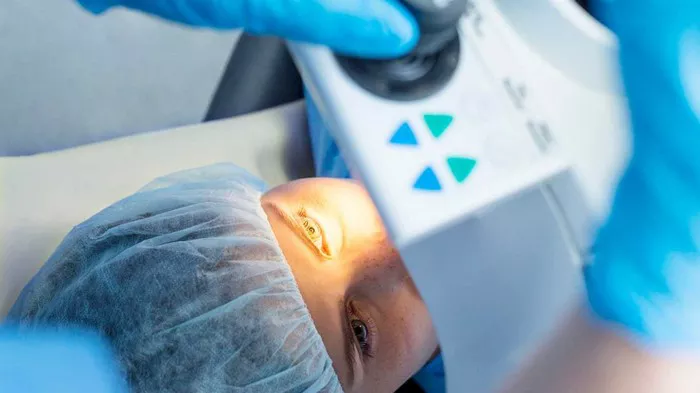Cataract surgery is a common and generally safe procedure. However, some patients experience cloudy vision postoperatively. Understanding the causes behind this can help in addressing the issue effectively. This article delves into the seven primary reasons for cloudy eyes after cataract surgery.
1. Posterior Capsule Opacification (PCO)
Description
Posterior Capsule Opacification (PCO) is one of the most common reasons for cloudy vision after cataract surgery. It occurs when cells from the natural lens’ remaining capsule proliferate and migrate to the back of the intraocular lens (IOL), creating a cloudy layer.
Symptoms
Gradual decline in vision clarity
Glare and halos around lights
Difficulty reading or performing detailed tasks
Treatment
YAG Laser Capsulotomy: This non-invasive procedure involves using a laser to create an opening in the cloudy capsule, restoring clear vision almost immediately.
2. Cystoid Macular Edema (CME)
Description
Cystoid Macular Edema (CME) is swelling of the macula, the central part of the retina, caused by fluid accumulation. It typically occurs within a few weeks after surgery.
Symptoms
Blurred or wavy vision
Reduced central vision
Distortion of images
Treatment
Non-steroidal anti-inflammatory drugs (NSAIDs): These can be administered as eye drops to reduce inflammation and swelling.
Steroid eye drops: These help in reducing inflammation more effectively.
Oral medications: In severe cases, oral medications might be necessary.
See Also: 6 Major Functions Of ICL In Ophthalmic Surgery
3. Residual Refractive Error
Description
Residual refractive error occurs when the eye does not focus light correctly after surgery, leading to blurry vision. This might be due to an inaccurate IOL power calculation or changes in the cornea post-surgery.
Symptoms
Blurred vision at certain distances
Double vision
Headaches and eye strain
Treatment
Eyeglasses or contact lenses: Corrective lenses can address residual refractive errors effectively.
LASIK or PRK surgery: These refractive surgeries can correct residual errors more permanently.
4. Dry Eye Syndrome
Description
Dry eye syndrome can be exacerbated by cataract surgery due to changes in tear film dynamics and temporary damage to the corneal nerves during the procedure.
Symptoms
Scratchy or burning sensation
Redness and irritation
Blurred vision that improves with blinking
Treatment
Artificial tears: Frequent use of lubricating eye drops can alleviate dryness.
Punctal plugs: These tiny devices are inserted into tear ducts to reduce tear drainage.
Prescription eye drops: Medications such as cyclosporine can increase tear production.
5. Intraocular Lens (IOL) Dislocation
Description
IOL dislocation occurs when the implanted lens moves out of its intended position. This can happen due to inadequate healing or trauma to the eye.
Symptoms
Sudden blurring or doubling of vision
Seeing edges of the lens implant
Eye discomfort
Treatment
Observation: Minor dislocations might not require immediate intervention.
Surgical repositioning or replacement: Significant dislocations often need surgical correction to reposition or replace the IOL.
6. Inflammation and Infection
Description
Post-surgical inflammation or infection can lead to cloudy vision. Inflammation is a natural response but can sometimes persist longer than expected. Infection, although rare, can be serious.
Symptoms
Pain and redness in the eye
Sensitivity to light
Decreased vision
Treatment
Steroid and antibiotic eye drops: These help reduce inflammation and treat any potential infections.
Oral antibiotics: In severe cases, oral medication may be required.
Intravitreal injections: Direct injection of antibiotics into the eye might be necessary for severe infections.
7. Retinal Detachment
Description
Retinal detachment is a serious condition where the retina separates from the back of the eye. Cataract surgery slightly increases the risk of retinal detachment.
Symptoms
Sudden appearance of floaters
Flashes of light
Shadow or curtain over part of the visual field
Treatment
Laser surgery (photocoagulation): Seals retinal tears or holes.
Cryopexy: Freezing therapy to repair retinal tears.
Vitrectomy: Surgical removal of the vitreous gel and repairing the retina.
Preventive Measures and Follow-Up Care
Preoperative Measures
Thorough eye examination
Accurate IOL measurements
Managing pre-existing eye conditions
Postoperative Care
Regular follow-up visits
Adhering to prescribed medication schedules
Reporting any unusual symptoms immediately
Conclusion
Cloudy vision after cataract surgery can stem from various causes, each requiring specific interventions. Understanding these causes enables better patient outcomes through timely and appropriate treatments. Regular follow-up and adherence to medical advice are crucial in ensuring optimal recovery and maintaining clear vision post-surgery.
Related topics:

